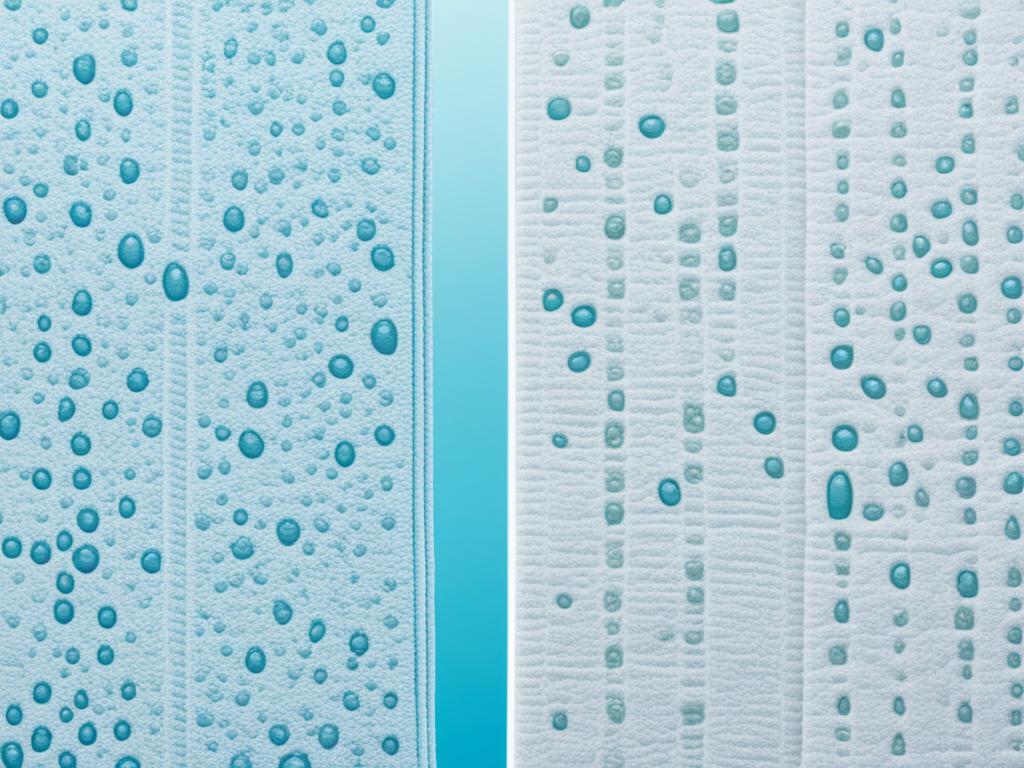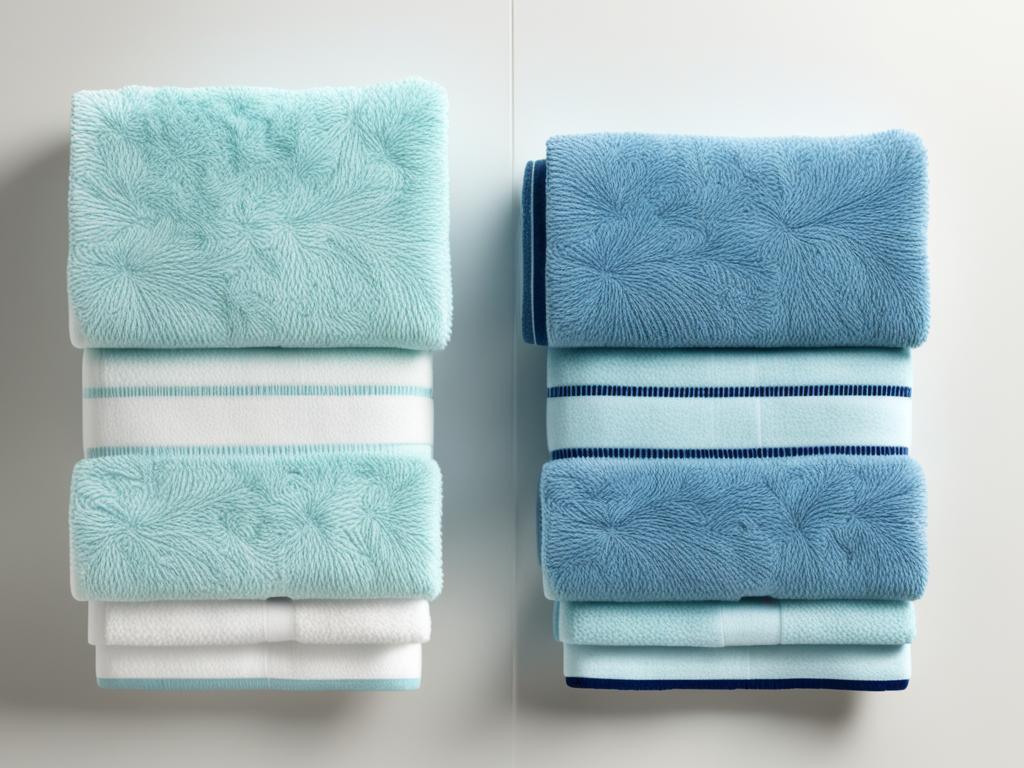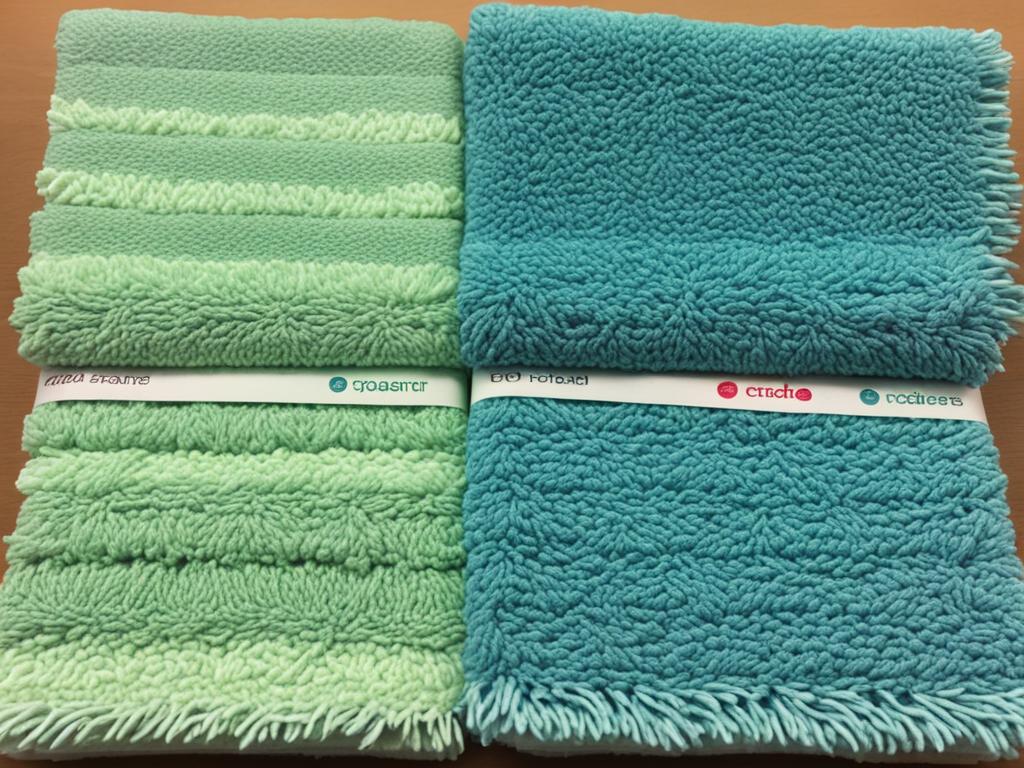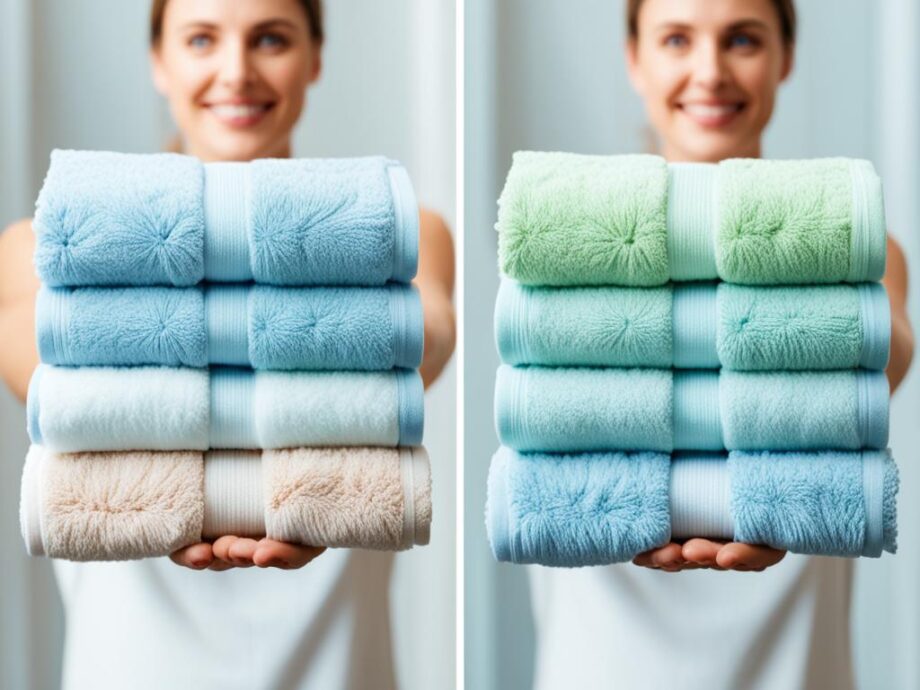In our daily lives, towels play a crucial role in maintaining hygiene and cleanliness. However, not all towels are created equal. Two common types of towels, face towels and hand towels, serve different purposes and have their own unique characteristics. Understanding the difference between the two can help you choose the right towel for various needs.
So, what sets face towels and hand towels apart? Let’s explore their differences in this article and discover their best uses.
Key Takeaways:
- Face towels and hand towels differ in their absorbency and size.
- Face towels are designed to be more absorbent and smaller in size, making them ideal for facial care.
- Hand towels are larger and may not be as absorbent for facial use, but they are suitable for drying hands.
- The material used in face towels and hand towels is also different, with face towels often made from softer materials for gentle cleansing.
- Consider your specific needs and preferences when choosing between face towels and hand towels.
Absorbency
When comparing face towels and hand towels, one key factor to consider is absorbency. The absorbent capabilities of these towels differ due to their design and size.
Face towels: Face towels are specifically designed to be more absorbent, making them ideal for facial use. With a smaller surface area, face towels can effectively soak up moisture and oils from the face, leaving the skin feeling refreshed and clean. This absorbency is crucial for facial care routines, as it helps remove impurities and excess product.
Hand towels: Although hand towels are generally larger in size, they may not be as absorbent as face towels when it comes to facial use. These towels are primarily designed for drying hands and larger areas of the body. Their larger size offers more coverage and convenience in hand-drying situations, such as in bathrooms or kitchens.
Overall, the absorbency of face towels surpasses that of hand towels when it comes to facial care. The smaller size and focused capabilities of face towels make them superior in effectively absorbing moisture and impurities from the delicate facial skin.

Comparing Absorbency
| Face Towels | Hand Towels |
|---|---|
| Smaller size for better absorption on the face | Larger size for drying hands and larger body areas |
| Designed to be more absorbent | May not be as absorbent for facial use |
| Ideal for removing impurities and excess product from the face | Convenient for hand-drying in bathrooms or kitchens |
Size
One of the key factors that differentiates face towels from hand towels is their size. Face towels are smaller, typically measuring around 13×13 inches, offering a compact and manageable option for facial cleansing. These dimensions make face towels perfectly suited for delicate facial skin, allowing for precise and targeted cleansing.
On the other hand, hand towels are larger in size, measuring around 15×25 inches. This larger size makes hand towels more suitable for drying hands or larger areas of the body, such as after a shower or bath.

By understanding the size differences between face towels and hand towels, you can choose the right towel for the task at hand, whether it’s providing gentle care for your face or drying off larger areas of the body.
Material
One of the key differences between face towels and hand towels is the material they are made of. Face towels are crafted from softer and more delicate materials, such as cotton, microfiber, or bamboo. These materials are chosen to ensure gentle cleansing and exfoliation of the face, as the facial skin is more sensitive and requires extra care. Face towels made from these materials offer a soft and luxurious touch, making them ideal for facial care routines.

On the other hand, hand towels may be made from a wider range of materials, depending on their intended purpose. While cotton and bamboo are common materials for hand towels, they may also be made from terry cloth, which provides increased absorbency and durability. Hand towels need to be more robust, considering the frequent usage and exposure to moisture. The different materials used in hand towels offer varying degrees of softness and effectiveness in drying.
To summarize:
| Face Towel | Hand Towel |
|---|---|
| Softer and more delicate materials | Wide range of materials |
| Cotton, microfiber, or bamboo | Cotton, bamboo, or terry cloth |
| Gentle cleansing and exfoliation | Drying and multi-purpose use |
Choosing the right material for your towel depends on your specific needs and preferences. If you prioritize gentle care and luxury in your facial routine, opting for a face towel made from soft materials like cotton, microfiber, or bamboo is the way to go. For hand drying and versatile use, hand towels made from materials such as cotton, bamboo, or terry cloth provide the durability and absorbency required.
Usage
When it comes to choosing between face towels and hand towels, understanding their intended usage is crucial in making the right decision. The primary purpose of face towels is to cater to facial care routines, such as cleansing, exfoliating, and applying skincare products. Their smaller size and gentler materials make them ideal for delicate facial skin.
On the other hand, hand towels are primarily used for drying hands. However, they can also serve various purposes beyond hand drying. Hand towels can be used for drying off after a refreshing shower or bath, making them versatile and practical for multiple hygiene needs.
Let’s take a closer look at the specific uses and advantages of both face towels and hand towels:
Face Towels: Perfect for Facial Care
- Ideal for cleansing: Face towels are designed to effectively remove dirt, oil, and makeup from the face, providing a thorough and gentle cleanse.
- Exfoliation: The soft and absorbent nature of face towels makes them suitable for gentle exfoliation, promoting smoother and healthier-looking skin.
- Skincare application: Face towels can help evenly distribute skincare products, ensuring better absorption and maximizing their benefits.
Hand Towels: Beyond Hand Drying
- Hand drying: Hand towels excel at efficiently drying hands, providing a hygienic solution for personal and public spaces.
- Body drying: In addition to hand drying, hand towels can be used to dry off the body after bathing, especially in situations where larger bath towels are not available.
- Multipurpose use: Hand towels can also serve as a handy tool in the kitchen for drying dishes or wiping spills, making them indispensable in various household tasks.
Understanding the specific uses and advantages of face towels and hand towels enables you to make informed choices based on your requirements. Whether it’s for targeted facial care or versatile hand drying, both towels play essential roles in maintaining cleanliness and promoting personal hygiene.
Comparison
When it comes to choosing between face towels and hand towels, understanding their differences is essential. Face towels are smaller, more absorbent, and made from softer materials that provide gentle care for the face. On the other hand, hand towels are larger, less absorbent for facial use, but are ideal for drying hands and other parts of the body.
Let’s take a closer look at the comparison:
| Factors | Face Towel | Hand Towel |
|---|---|---|
| Size | Smaller (around 13×13 inches) | Larger (around 15×25 inches) |
| Absorbency | More absorbent for facial use | Less absorbent for facial use, but suitable for hand and body drying |
| Material | Softer materials for gentle facial care, such as cotton, microfiber, or bamboo | Various materials depending on the intended purpose, including cotton, bamboo, or terry cloth |
| Usage | Ideal for facial care routines, including cleansing, exfoliating, and skincare application | Primarily used for drying hands, but can also be used for showering and bathing |
Consider your specific needs and preferences when deciding between face towels and hand towels. If you prioritize gentle care for your face, a smaller and more absorbent face towel would be the better choice. However, if you need a towel for hand and body drying, a larger hand towel would be more practical.
Remember, both face towels and hand towels serve different purposes, and having a combination of both can be beneficial for various situations and needs.
Practical Considerations
When choosing between face towels and hand towels, practical considerations play a crucial role in finding the perfect fit for your needs. Factors such as the number of towels required, storage space availability, and cost should all be taken into account.
Face towels are typically used more frequently for facial care routines, making them an essential staple in many skincare regimens. The smaller size and gentle materials of face towels make them ideal for cleansing, exfoliating, and applying skincare products to the delicate skin on your face. If you prioritize facial care, investing in a sufficient number of face towels would be beneficial.
On the other hand, hand towels are often used in greater quantities in bathrooms and kitchens. Their larger size allows for better coverage when drying hands or other parts of the body after a shower or bath. Since hand towels serve multiple purposes and are used more widely, it’s essential to consider how many you may need for different areas of your home.
Tip: Consider purchasing hand towels in bulk to ensure you have an ample supply for various rooms or use them across all areas of your home.
Storage space is another practical consideration. Face towels, with their smaller size, are easier to store in tight spaces such as medicine cabinets or vanity drawers. On the other hand, hand towels, with their larger dimensions, may require more storage room, such as in linen closets or shelves.
Lastly, cost can be a factor when deciding between face towels and hand towels. Face towels, often made from softer and more delicate materials suitable for facial care, may be slightly more expensive than hand towels. However, hand towels, being larger and used in greater quantities, may require a larger budget to ensure an adequate supply for all areas of your home.
To help you visualize the practical considerations when choosing between face towels and hand towels, here’s a comparison table:
| Face Towels | Hand Towels | |
|---|---|---|
| Usage | Frequent for facial care routines | Widely used in bathrooms and kitchens, greater quantity |
| Size | Smaller, compact | Larger, more coverage |
| Storage Space | Easier to store in tight spaces | May require more storage room |
| Cost | Slightly more expensive | May require a larger budget |
Considering practical factors like usage, size, storage space, and cost can help you make an informed decision when choosing between face towels and hand towels.
Conclusion
Understanding the differences between face towels and hand towels can help you make informed decisions based on your specific needs. Both towels have their unique advantages, and choosing the right one depends on the intended purpose and personal preferences.
When it comes to absorbency, face towels are designed to be more absorbent, making them ideal for facial care routines. On the other hand, hand towels are larger and better suited for drying hands or larger areas of the body.
Size is another factor to consider. Face towels are smaller, providing a compact and manageable option for facial cleansing, while hand towels are larger and offer more coverage.
The materials used also differ. Face towels are often made from softer and more delicate materials, such as cotton, microfiber, or bamboo, for gentle cleansing and exfoliation. Hand towels, on the other hand, may be made from a wider range of materials depending on their intended purpose.
Practical considerations, such as the number of towels needed, storage space, and cost, should also play a role in your decision. Face towels may be used more frequently for facial care routines, while hand towels may be used in greater quantities in bathrooms or kitchens.
Ultimately, consider absorbency, size, material, and practical considerations when selecting the perfect towel for your needs. Whether you’re looking for a towel for facial care or hand drying, understanding the differences between face towels and hand towels will help you find the most suitable option.
FAQ
What are the key differences between face towels and hand towels?
Face towels are designed specifically for facial care routines, while hand towels are primarily used for drying hands. They differ in terms of absorbency, size, material, and usage.
Are face towels more absorbent than hand towels?
Yes, face towels are typically designed to be more absorbent, with a smaller surface area for better moisture absorption on the face. Hand towels, on the other hand, may not be as absorbent for facial use.
What is the size difference between face towels and hand towels?
Face towels are smaller, usually measuring around 13×13 inches, making them compact and manageable for facial cleansing. Hand towels, on the other hand, are larger, measuring around 15×25 inches, making them better suited for drying hands or larger areas of the body.
What materials are commonly used in face towels and hand towels?
Face towels are often made from softer and more delicate materials such as cotton, microfiber, or bamboo to ensure gentle cleansing and exfoliation of the face. Hand towels can be made from a wider range of materials, including cotton, bamboo, or terry cloth, depending on their intended purpose.
What are the primary uses of face towels and hand towels?
Face towels are specifically designed for facial care routines, including cleansing, exfoliating, and applying skincare products. Hand towels are primarily used for drying hands but can also be used for drying off after a shower or bath.
How do face towels and hand towels compare?
Face towels are smaller, more absorbent, and made from softer materials for gentle facial care. Hand towels are larger, less absorbent for facial use, but suitable for drying hands and other parts of the body. The choice depends on intended use and personal preferences.
What practical considerations should I keep in mind when choosing between face towels and hand towels?
Consider factors such as the number of towels needed, storage space, and cost. Face towels are often used more frequently for facial care routines, while hand towels may be used in greater quantities in bathrooms or kitchens.
How can I choose the right towel for my needs?
Understanding the differences between face towels and hand towels, including absorbency, size, material, and practical considerations, will help you make an informed decision based on your specific needs and preferences.
What is the best towel for facial care?
The best towel for facial care depends on individual preferences and needs. Face towels are specifically designed for gentle facial care, with softer materials and smaller sizes. Consider your skin type, cleansing routine, and desired level of exfoliation when choosing a towel for facial care.
Can I use a hand towel instead of a face towel?
While you can use a hand towel instead of a face towel if you don’t have one available, it may not be as suitable. Hand towels are larger and may not be as absorbent or gentle on the face as dedicated face towels. It’s best to use a towel specifically designed for facial care for optimal results.
